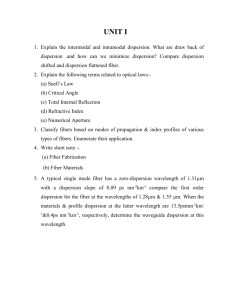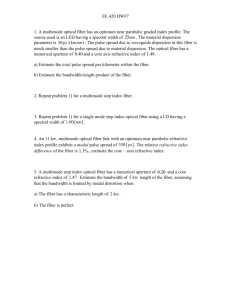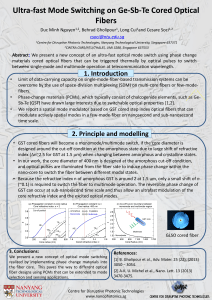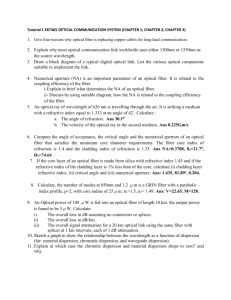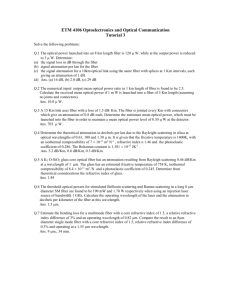File - Bit2byte
advertisement
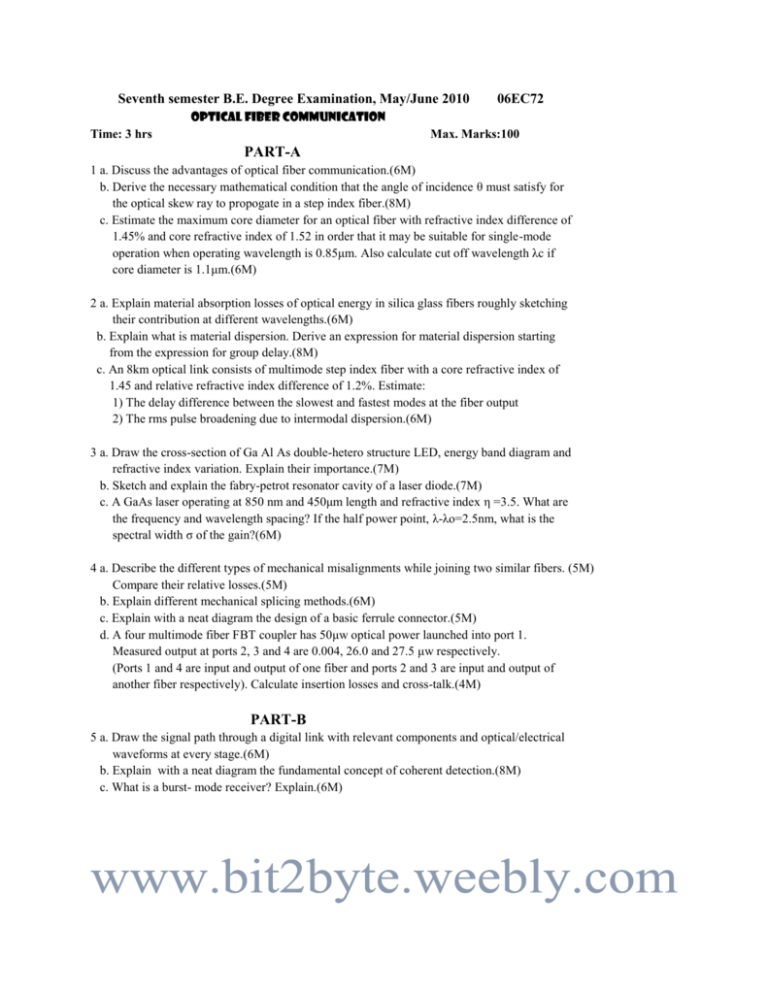
Seventh semester B.E. Degree Examination, May/June 2010 06EC72 optical fiber communication Time: 3 hrs Max. Marks:100 PART-A 1 a. Discuss the advantages of optical fiber communication.(6M) b. Derive the necessary mathematical condition that the angle of incidence θ must satisfy for the optical skew ray to propogate in a step index fiber.(8M) c. Estimate the maximum core diameter for an optical fiber with refractive index difference of 1.45% and core refractive index of 1.52 in order that it may be suitable for single-mode operation when operating wavelength is 0.85μm. Also calculate cut off wavelength λc if core diameter is 1.1μm.(6M) 2 a. Explain material absorption losses of optical energy in silica glass fibers roughly sketching their contribution at different wavelengths.(6M) b. Explain what is material dispersion. Derive an expression for material dispersion starting from the expression for group delay.(8M) c. An 8km optical link consists of multimode step index fiber with a core refractive index of 1.45 and relative refractive index difference of 1.2%. Estimate: 1) The delay difference between the slowest and fastest modes at the fiber output 2) The rms pulse broadening due to intermodal dispersion.(6M) 3 a. Draw the cross-section of Ga Al As double-hetero structure LED, energy band diagram and refractive index variation. Explain their importance.(7M) b. Sketch and explain the fabry-petrot resonator cavity of a laser diode.(7M) c. A GaAs laser operating at 850 nm and 450μm length and refractive index η =3.5. What are the frequency and wavelength spacing? If the half power point, λ-λo=2.5nm, what is the spectral width σ of the gain?(6M) 4 a. Describe the different types of mechanical misalignments while joining two similar fibers. (5M) Compare their relative losses.(5M) b. Explain different mechanical splicing methods.(6M) c. Explain with a neat diagram the design of a basic ferrule connector.(5M) d. A four multimode fiber FBT coupler has 50μw optical power launched into port 1. Measured output at ports 2, 3 and 4 are 0.004, 26.0 and 27.5 μw respectively. (Ports 1 and 4 are input and output of one fiber and ports 2 and 3 are input and output of another fiber respectively). Calculate insertion losses and cross-talk.(4M) PART-B 5 a. Draw the signal path through a digital link with relevant components and optical/electrical waveforms at every stage.(6M) b. Explain with a neat diagram the fundamental concept of coherent detection.(8M) c. What is a burst- mode receiver? Explain.(6M) 6 a. Following are the parameters of a point-to-point optical link: 1) Optical power launched: + 5dBm 2) sensitivity of detector : -30dBm 3) Source/detector connector loss : 1dB 4) Length of optical cable : 55km 5) Cable attenuation : 0.3 dB/km 6) Jumper cable loss : 2.5 dB 7) Connector loss at each fiber joint : 1dB Assume two jumper cables and two cable joints. Compute the power margin of the line Explain the significance of power budget and system margin.(8M) b. In a multimode link using LED as optical source, material dispersion related rise time degradation is 20ns over the 5 km link. Receiver has 30 MHz bandwidth. Fiber has 500MHz. km bandwidth distance product with node mixing parameter q=0.7. Assume LED with drive circuit has rise time of 15ns, calculate link rise time.(6M) c. Explain with a neat diagram the functioning of radio-over-fiber links of a broadband wireless access network.(6M) 7 a. Explain the operational principle and implementation of WDM with diagrams.(7M) b. Explain the functioning of optical isolator with sketches of components involved.(6M) c. Explain tunable light sources.(7M) 8 a. Explain in detail the amplification mechanism with energy level diagram in an EDFA.(8M) b. Draw and explain the basic structure of an STS-N SONET and STM-N SDH frames.(6M) c. Explain the working of ultra-fast point-to-point transmission system using optical TDM operating at 160Gb/s with a neat diagram.(6M) ******************************************************************************


